#family equidae
Text

Przewalski's Horse
Equus ferus ssp. przewalskii
吐尔洪乡, 阿勒泰地区, 新疆维吾尔自治区
Turhong Township, Altay Prefecture, Xinjiang Uygur Autonomous Region, China
45.271788, 88.766909
by almaatai
#genuinely thought this was a cave painting at first#equus ferus#wild horse#equus ferus ssp. przewalskii#china#equus#genus equus#horses#family equidae#equidae#m#mammals#anyways. !!!!!#inaturalist
7K notes
·
View notes
Video
Wild Wild West - Wild Horses of Alberta by Georgie Alexon
Via Flickr:
This family of wild horses was standing beside a country road in the foothills of the Rocky Mountains. The young foal was standing in front of his mother who has her head resting on his back. There are about 900 wild feral horses in Alberta. - Equus ferus
#wild#horses#equine#countryside#animal#wildlife#nature#mountains#photography#canon#eos#trees#green#summer#family#Equus#ferus#Equidae#mammals#foal#baby#colors#flickr
42 notes
·
View notes
Text

Przewalski's Horse (Equus ferus przewalskii), family Equidae, Mongolia
This was once thought to be a totally different species from the domestic horse, but recent genetic/archeological research has uncovered that these animals are a long feral population of Botai Horses. (The horses of the Botai people of central Asia). They have now been placed in the species, Equus ferus, the species from which domestic horses were likely domesticated.
These findings are still in dispute.
photograph by marleosch
173 notes
·
View notes
Text
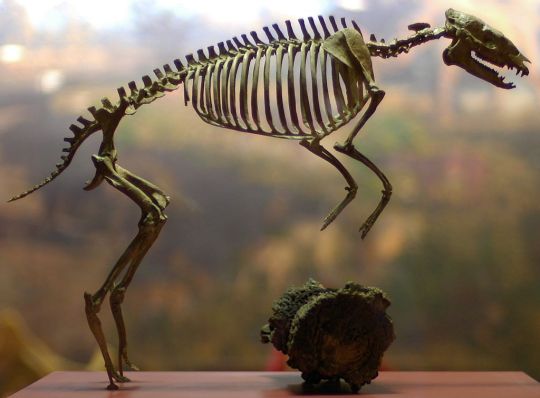
September's Fossil of the Month: Hyracotherium (Hyracotherium spp.)
Family: Horse family (Equidae) or Paleothere family (Palaeotheriidae)
Time Period: Early Paleogene (55-45 Million Years Ago)
Living across much of what is now Europe and North America, the members of the genus Hyracotherium were early members of the order Perissodactyla (the group of mammals to which horses, tapirs and rhinoceroses belong,) and are believed by some authorities to be among the earliest known members of the horse family, although some palaeontologists instead regard them as belonging to a separate but related extinct family of small, horse-like Perrisodactyls known as paleotheres (which would make them relatives or possibly ancestors of modern horses, but not technically true horses themselves.) Though notably horse-like in terms of their overall anatomy, members of this genus were small animals (growing to be 30-60cm/11.8-23.6 inches tall and weighing around 9kg/20lbs,) and, in contrast to the feet of modern horses (which consist of a single toe enclosed in a hardened hoof of keratin, forming a sort of built-in shoe well suited to running on flat surfaces,) had separate hoof-tipped toes on each foot (4 on the front feet and 3 on the back feet) which may have aided them in walking on the uneven, muddy ground of the dense forests that would have covered much of their range at the time. Further distinguishing Hyracotherium species from modern horses is their teeth, which (in contrast to modern horses which have long incisors for grasping and tearing grasses and tall crowns on their molars to protect them from being worn down when chewing tough plants,) consisted of relatively small incisors and short-tipped crowns, suggesting that, as forest dwellers, members of this genus fed on fruits, shoots and low-growing leaves much like many modern forest antelopes. Throughout the Paleogene period, temperatures gradually became cooler and drier compared to the period's warm, humid beginning, and this change in climate led the then abundant rainforests that Hyracotherium species inhabited to be gradually replaced with open grasslands and temperate woodlands. This drastic change led to the extinction of many forest-dwelling specialists towards the end of the Paleogene, but also provided a new selective pressure that would eventually result in the surviving descendants of many forest specialists adapting to life on open plains - by 37 million years ago the members of the genus Mesohippus (which are unanimously excepted as early true horses) had lost the 4th toes on their forefeet and developed longer legs and larger bodies as they adapted to life in open habitats, and roughly 22 million years later the members of the genus Merychippus were larger still, bore their weight on only one toe per foot (though two tiny, presumably vestigial toes still remained,) and had tall crowns that would have allowed them to graze on the abundant tough grasses that surrounded them. Today, the anatomical changes that can be seen in the transition between paleotheres like Hyracotherium and the modern horses of the genus Equus are commonly used as a textbook example of how lineages of organisms have changed and adapted in response to environmental changes over time.
--------------------------------------------------------------------------
(Note - Depending on who you ask, the fossil pictured above may belong to the species Hyracotherium angustidens or to a separate but related animal, Eohippus angustidens. Some authorities consider Eohippus to be the only species in its own distinct genus, while others consider it to simply be a species in the genus Hyracotherium. For the sake of this post, and because the image above is VERY pretty, I've assumed here that the latter is true.)
Image Source: https://commons.wikimedia.org/wiki/File:HyracotheriumVasacciensisLikeHorse.JPG
#Hyracotherium#animal#animals#zoology#biology#mammalogy#paleontology#wildlife#prehistoric wildlife#horse#horses#prehistoric mammals#prehistoric horses#fossil#fossils#paleogene#paleogene wildlife
71 notes
·
View notes
Text
sorry for the existentialism tonight but i have a lot of thoughts. Comparisons between debates about evolution and politics below cut.
I've had this thought before but i feel like i need to put it in words.
I think that we can draw major parallels between how our view on evolution has changed over time, and how (at least American) politics are evolving.
Evolution Deniers
For one in the beginning of the evolution debates - and still to this day - we saw people completely refuting evolution, they didn't want to acknowledge that things are constantly changing. We can compare this to many conservative viewpoints nowadays.
Conservatives, as the name suggests, typically focus on "conserving" traditional American values. They feel threatened by the idea that their way of life is going out of style, just as many evolution deniers feel threatened that they aren't necessarily considered the "perfect life form".
Ladder Evolution Bias
We can compare politics to the hindsight bias many proponents of evolution first used to explain and show evidence for evolution, the seemingly linear evolution of the Equus genus. Scientists in the past would try and draw a definitive line from Eohippus, through: Orohippus, Epihippuus, Mesohippus, Miohippus, Parahippus, Merychippus, Pliohippus, and Dinohippus, all the way to modern day Equus.
However in modern times with the help of more extensive fossil records and a better understanding of the fossil record, we can tell there were many other "off branches", (though you can't really call it that if there was no main branch in the first place), of other evolutionary trees stemming from Eohippus that all had the same "goal" of becoming the most efficient at filling a certain ecological niche, that weren't as successful and became extinct, leaving Equus the only Extant genus of the Equidae family.
Many conservatives AND liberals have the point of view of "The future liberals want", and a "liberal agenda" and while those exact phrases are meant to fearmonger, similar words come out of liberal politicians mouths too. This, in my opinion, means that liberals are trying to personally push ideas, not follow the want/benefit of the people. But, in my opinion, liberal ideology is all about change and reflecting the changing needs of the people, not a set trajectory of political objectives, even though it is easy to draw a clear connections through the evolution of liberal ideology.
Modern Understandings of Evolution
In the modern day we understand that evolution is nonlinear and had no set trajectory. Animals change with the natural pressures around them. And i think the same can be said for liberal ideologies, the main basis of liberal ideology is reflecting the ever changing society we live in.
For example the modern push against capitalism. This view only came about due to external factors like late stage capitalism. I'm sure in the 16 and 1700's there was people pushing against Mercantilism in favor of capitalism since they had nothing to trade and thus could hardly acquire food let alone other commodities, so they preferred to work for personal "capital" creating capitalism. This was probably considered what would nowadays be called more liberal, pushing for change that would benefit the lower class.
and now capitalism hinders people from getting food or other commodities due to wealth hoarding, so many people advocate for a more socialist economic system to prevent wealth hoarding. Pushing for a change that would benefit the lower class
(If your reading this thanks :) this took me 2 hours to write cus i got into a rabbit hole of a creationist trying to break down the ladder model of evolution as a end all be all argument against evolution.)
#If your reading this thanks :)#this took me 2 hours to write#cus i got into a rabbit hole#of a creationist trying to break down the ladder model of evolution as a end all be all argument against evolution#punk#anti capitalism#anticapitalist#anti capitalist#socialism#evolution#politics#american politics#analogies#mercantilism#original rambles
20 notes
·
View notes
Photo
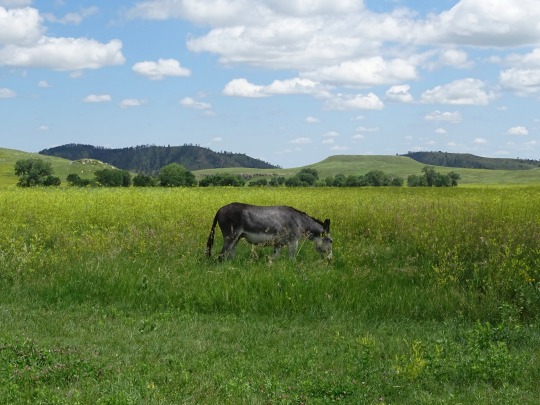

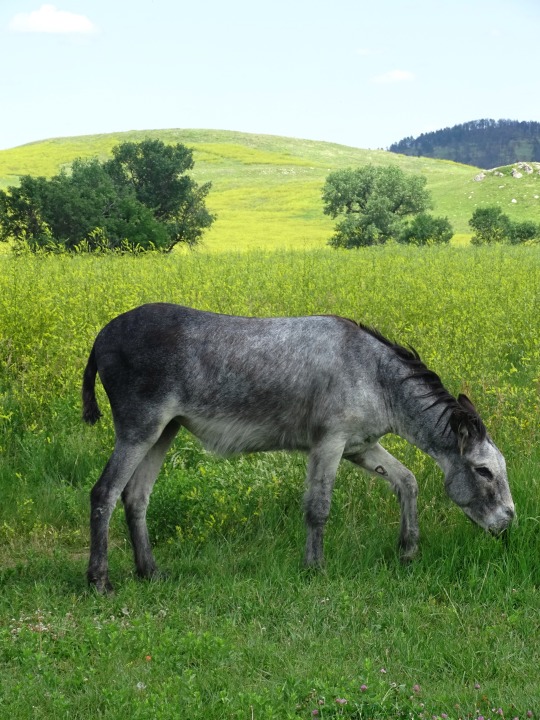


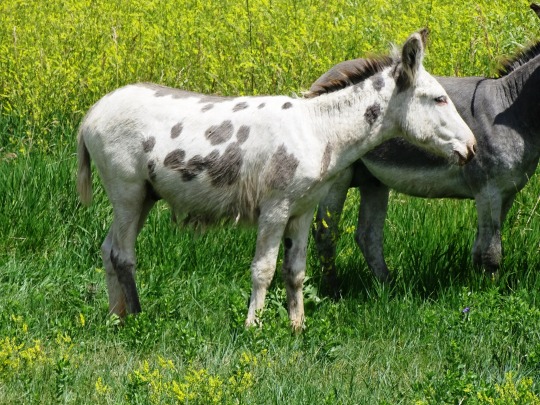
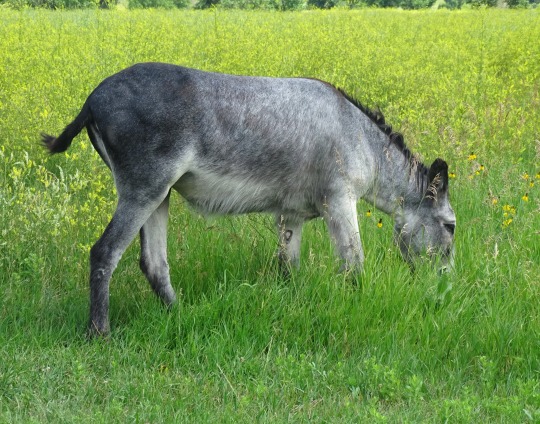

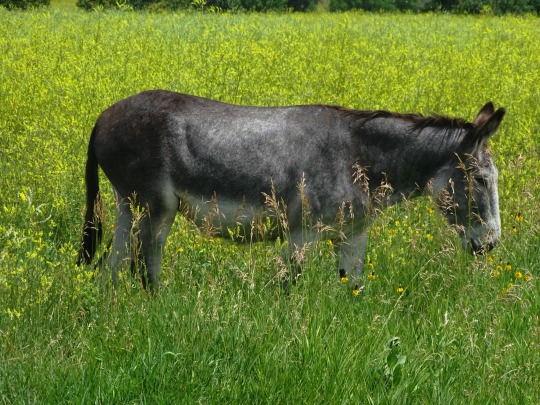
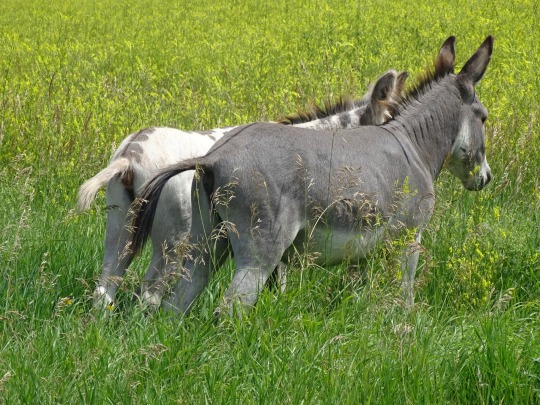
World Donkey Day
Visit a petting zoo, or simply do some research into the underappreciated, stalwart, useful and intelligent beasts of burden known as donkeys.
World Donkey Day is a show of respect for one of the most enduring and respectable animals in the Equidae family. Throughout history, it has served throughout the world as both a mount and a beast of burden in some of the most challenging terrains and forbidding climates, and has done so with pride and endurance. It’s unsurprising that these beasts’ success is due in part to their stubborn nature, and World Donkey Day honors them for this along with their other, perhaps more laudable, traits.
History of World Donkey Day
Two subspecies of the donkey, the Somalian and the Nubian, were bred together to produce what we think of as the modern Donkey. Available evidence points to the Donkey having been working alongside humanity since 4000 BCE, most likely in Nubia, as a more versatile and resilient pack animal than the ox they were presently using. Since then they have been bred and transplanted all over the world as cultures moved, and the world expanded, and can now be found just about everywhere.
They’re also the progenitors of the sterile mule, a cross-breeding of horse and donkey that results in a breed with the strengths of both. Sadly mules are almost entirely sterile, and the exceptions so rare that no breeding stock of pure mules has ever been able to be achieved, in part due to there having yet to be recorded a case of a breedable mule stallion. Strangely, there have been cases where female mules have birthed what are, for all appearances, pure horses when bred with a horse.
Without the help of donkeys, it is hard to imagine that the modern world could ever have come into existence. These hardy pack animals provided civilization with the motive energy needed to generate wealth, well before the advent of steam power or electricity. For that reason, many people consider donkeys just as fundamental to our society as writing, pottery, and metallurgy.
World Donkey Day is all about celebrating their stoic spirit and individual charm. These creatures aren’t afraid of a hard day’s work. In fact, they more or less invented the concept. Donkeys pull carts, operate mills, and carry cargo for miles and miles, well after other species would have given up. For that reason, they have a special place in our hearts. They’re willing to put in the effort (for no pay) all to serve us – their grateful human masters.
World Donkey Day is the brainchild of Raziq Ark, a scientist whose interests primarily concern desert animals. Around ten years ago, he noticed that nobody was celebrating the humble donkey for its efforts in helping people all over the world improve their quality of life. In recognition of all this hard work, he set up a Facebook group, chronicling the trials and tribulations of the species all over the world. Eventually, the idea to set up a World Donkey Day emerged in 2018, and we’ve been celebrating it ever since.
The concept drew widespread attention in the media. The Daily Express, for instance, ran an article covering ten facts that people don’t know about donkeys. Did you know that a female donkey is called a Jenny? Ark also has thousands of followers on his Facebook page, all showing their support for this amazing creature.
Donkeys have played an essential part in human history. Ark says that they are a “precious genetic resource and a great gift of nature.” You can’t get higher praise than that!
How to celebrate World Donkey Day
The best way to celebrate World Donkey Day, depending on where you are, is merely to research these incredible beasts and the role they had to play in the world. If you’re somewhere you can take a Donkey Ride tour like the Grand Canyon or tours of certain abandoned mines then that’s an even better way to become acquainted with these adorable long-eared equines. World Donkey Day reminds us that we owe a large part of our success on this planet to these fellow travelers on the starship Earth.
There are plenty of other ways that you can show your support to donkeys all over the world and improve their wellbeing. Many of them are in constant pain and need attention fast. Often their owners are too poor to pay for a veterinarian, so it falls to the rest of us to take up the slack. Donating to a donkey charity, therefore, is a great way to show your support for these fabulous creatures directly. Currently, there are a handful of nonprofits working hard all over the world to deliver medical attention to neglected and abused animals. These charities use donated money to provide much-needed treatment to donkeys in their hour of need.
Donkey abandonment is another major issue. Many owners will dump their donkeys at the side of the road if they can no longer afford to take care of them. The animal must then scavenge for food to survive. Giving to a donkey charity, therefore, can provide these victims with shelter where they can live in safety and peace.
Donkeys are beautiful, but neglected creatures. World Donkey Day is a chance for everyone who cares about these animals to highlight their plight and do something practical about it. Are you in?
Source
#Custer State Park#I love Custer State Park#flora#fauna#wildlife#wildflower#begging burro#Oatman#Arizona#summer 2019#2014#original photography#Black Hills#South Dakota#landscape#meadow#USA#countryside#North Central Region#tourist attraction#Orlando#cityscape#World Donkey Day#WorldDonkeyDay#8 May
30 notes
·
View notes
Text
🌕 🌖 🌗 🌘 🌑 🌒 🌓 🌔 🌕

Hey there! My name is Luna, you can also call me Moon. I'm a primarily spiritual therian and otherhearted. I awakened in 2012. My main blog is @iridescentclaws so likes and follows come from there.
You can find my tag list here. And if you're looking to submit a request, check out my guidelines here.
Also, consider joining the Equidae Discord & Forum! An Equine Alterhuman community!

About Me
As I stated before, I'm primarily a spiritual therian. I believe my soul is nonhuman. That my theriotypes are different forms of my true self. This blog is one way I cope with my species dysphoria, I post about myself and my experiences as a therian.

(↑ Art by me)
As a seal, I am a harp seal pup (Pagophilus Groendlandicus) in the white coat stage. I don't have any distinct features, just the usual white fur. Black snout, whiskers/whisker spots, claws and eyes.

(↑ Art by me)
As a wolf, I am a black and beige/cream Northwestern wolf with greenish yellow (Canis Lupus Occidentalis). I think of pretty average size? Might be a little on the smaller side. Also, It's most likely influenced by my life now as a human, but I do have a lot of dog-like behaviors which I've picked up.

(↑ Art by me)
As an alicorn, I'm really just a horse (Equus Caballus) but with a unicorn horn and feathered wings. I know very little about this side of myself besides whatever I can intuit or just what I feel sounds right. I look very much like an Irish Cob but I'm about as tall as a Clydesdale (About 6ft at the shoulder). All of my fur and hair is white, my eyes are light blue, and my horn and hooves opalescent/pearlescent. I have no idea if there are any more define features/behaviors. It can be hard to tell as I have a lot of overlapping phantom and sometimes mental shifts.

(↑ Art by me)
Lastly, I am orca & cat hearted. While I do not identify as either an orca or cat, I do sometimes experience shifts of either. My connection to orcas is inexplicably spiritual but my connection to cats I would say is almost purely psychological. Regardless, both species are like family to me and they are very important to me. I don't feel any particular connection to any ecotype or breed, it's just as a species.

Also, I don't feel comfortable with KFF or the term "kinnie". I cannot and will not stop anyone for using the term. I just would rather not be called it due to it's history and similarity to the transphobic slur.
13 notes
·
View notes
Text
A Natural Beauty of Yoki’s Farm


Photographic Treasures from a Day Tour in the Yoki’s Farm, Mendez Cavite, Philippines on April 07, 2024.
The worm requires suitable soil to survive. The bird requires a tree for it to perch and then make its nest in. To produce honey, the bee must consume harmless nectar. The ladybird has to crawl on soft, padded ground. While the human person requires healthy, nutritious food, which mother nature gives in abundance. This is how Mother Nature flourishes naturally.
Yoki’s farm acts as an image for an everlasting dance of nature and human beings. This farm exists with the purpose of giving people information about the existence of animals and their habitat. Ecology has been created by this farm in order for humans to connect not only with animals but with nature as well.
— Gentle Charm of Alpaca

Capturing the beauty of Alcapa in the Yoki’s Farm, Mendez Cavite, Philippines on April 07, 2024.
Alcapas are considered the prettiest among the Camelidae family. With its fluffy fur, soulful eyes, demure grin, and slender neck make it stand out among the rest. This lovely creature, not merely signifies beauty and elegance, but also an extensive tradition and work of art.
— The Zebra’s Striped Symphony
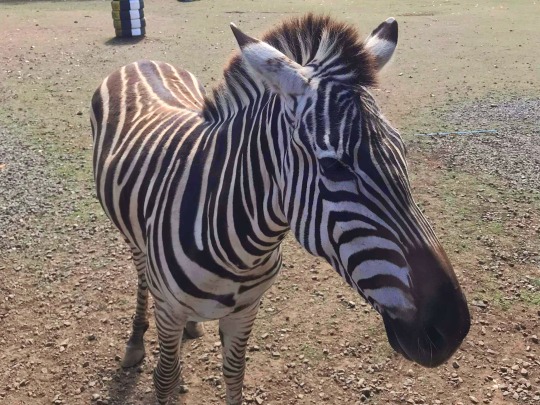
Captivating Beauty of Zebra in the Yoki’s Farm, Mendez Cavite, Philippines, taken on April 07, 2024.
Did you know that once a group of zebras merges, their stripes make it extremely difficult for attackers to tell apart single animals? And that a zebra's stripes, like human distinguishing fingerprints, are completely unique to each individual animal?
Horses and zebras are similarly related; they are not the same species, yet both belong to a similar family: the Equidae, commonly referred to as the Equus family. Despite the fact that they fall under the same family, zebras are not as easy to ride as horses since their bodies are smaller and possess a completely different disposition.
Another fact about zebras is that they may fall asleep standing up because they are equipped with locking joints, which reduces the possibility of falling over and allows them to get away quickly if enemies approach. To achieve a deep slumber, they must lie down.
Theme: Landscapes and Wildlife
#TravelWritingandPhotography
5 notes
·
View notes
Note
If you're still taking prompts I would absolutely love to see your take on "learning more about their interests so they have a common thing to talk about" for Geraskier ♡ Have a lovely day, I love to read your works.
Thank you so much, dear 💜
Jaskier had never been very studious. Oh, sure, he had his degree and all, but that was mostly because he was really good at pretending to know things and fill in the gaps with educated guesses. Somehow, it had all worked out. He had mastered history somehow, despite mostly using his text book to hide a bottle of ale behind it.
So. Jaskier had never been one sit sit over books and study.
Until now that was. Because now, it was a matter of life and death. Well, perhaps he was being a bit dramatic, but it certainly was a matter of great importance.
He drew his brows together in CO centration and leaned closer to the book, as if that would change anything about his ability to absorb the information.
The horse (Equus ferus caballus) is a domesticated, one-toed, hoofed mammal. It belongs to the taxonomic family Equidae and is one of two extant subspecies of Equus ferus (see footnotes).
Sweet Melitele, he couldn't count the times he had read that line and he still was none the wiser for it. And it was on the first page. The first sentence to be exact. He felt like there was simultaneously no new information and too much information in that one line.
He gritted his teeth and forced himself to read on.
He could do that. For Geralt, he could make it through this whole damn book and the five other books on different horse breeds, the history of war horses and the proper way of taking care of a horse, he had managed to hunt down at the Academy of Oxenfurt.
He would read them and he would understand them and he would woo Geralt with his impressive knowledge about horses.
He just had to keep reading.
Horses in the subspecies caballus are domesticated, although some domesticated populations...
Jaskier's eyelids grew heavy and he had to stifle a yawn. Somehow it was so much easier and more interesting to listen to Geralt talk about horse facts than it was to read about them. How could a book be so boring in comparison? Geralt wasn't even that great of a story teller. But the way he relaxed, his shoulders loosing their tension and an excited smile spreading over his face whenever he went on about the merits of different horse breeds somehow made it impossible not to hang on his lips.
Jaskier wanted so desperately to be able to talk to him about this topic that made Geralt so happy.
He flipped through the book until he found a picture. Even that was boring. Countless complicated annotations described different parts of the horse's anatomy.
He narrowed his eyes, but he couldn't for the life of him concentrate. His mind kept bouncing from thinkung about Geralt's smile to telling him to focus. It left no room in his head for the information in the book.
With a groan, Jaskier dropped his head on the book. At least it made a decent pillow. That was the least it could do, for making him so sleepy.
Maybe, Jaskier wouldn't be able to make it through that book after all. But maybe, he didn't have to. Maybe it would be much better to simply ask Geralt about horses.
With a smile on his lips, Jaskier fell asleep and dreamed about the way Geralt would light up when he saw that Jaskier wanted to listen to him rant endlessly about horses.
(credit for the horse facts goes to this Wikipedia article)
49 notes
·
View notes
Text


Fossil Dawn Horse (Protorohippus venticolus, Early Eocene) - Fossil Lake, Kemmerer, Wyoming
One of two horse skeletons discovered in Wyoming’s Green River Formation. The five fish embedded in the slab are a testament to the rare circumstances that led to this land animal being buried in the middle of Fossil Lake. The details of this intriguing occurrence remain a mystery. One suggestion is that the horse was fleeing a predator and it made its way to shallow water, but was swept away into to the middle of the lake where it eventually drowned.
Protorohippus venticolus is the most primitive species of the Equidae family. This diminutive horse was only 20 inches (50 cm) tall at the shoulders and about two feet (60 cm) long as an adult. Interestingly, it had four padded hoofed toes on its front legs and 3 on its long hind legs. Its grinding teeth were well-suited to a diet of fruit and leaves, which were abundant in the subtropical climate that it inhabited.
2 notes
·
View notes
Photo
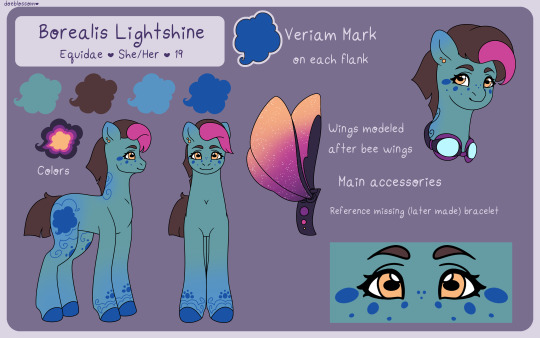
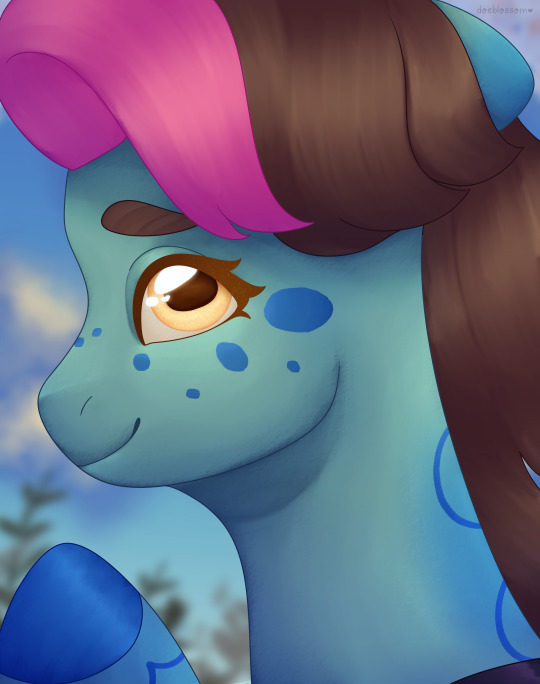
This is Borealis Lightshine!
Borealis Lightshine is an equidae born to a family of pegasi. She wants to fit in, and with her love of stunt fliers, has crafted prosthetic wings to use with her magic.
Borealis’s tag is #borealis lightshine!
#borealis lightshine#equidae#ask-narratordoe#ask narratordoe#ask narrator doe#reference sheet#mlp#mlp au#asteros au
28 notes
·
View notes
Text
I was briefly considering redoing a very old Percy Jackson fic I found that was terribly written but had a great plot. It was my own, to clarify, and from the era of Wattpad that was filled with ---line breaks--- and naming these dots: •. The era that I remember for having an account called Leo and the Whale Watchers that would call out, "WHALE" in the comments whenever this -_- emoticon showed up in a fic they were reading.
Anyways. This fic was probably eight-ish years old, and since then I have learned many things. I am using that knowledge here. FYI: I am not assuming anyone here doesn't know biology, I am just putting it here so anyone who doesn't has access to it without research.
Taxonomical Ranks are used to assess relatedness and group species together. From most vague to most specific we have: Kingdom, Phylum, Class, Order, Family, Genus, and Species. Scientific names are always Genus species. For reference, the taxonomy of a human is Animalia, Chordata, Mammalia, Primate, Hominidae, Homo sapien.
This is all to say, I have officially made a list of what Oceanic Animals would actually be the equivalent of, based on behavior and phylogeny (def.: relatedness of distant species based on most recent common ancestor), as someone studying to become an ethologist (def.: a scientist who studies animal behavior) and mammalogist (def.: a scientist who studies mammals). Gotta be flexible in this career field, Individuals.
Without further ado:
Dogs - Pinnipeds! Seals/Sea Lion/Walruses
Phylogeny: Like all marine mammals, Pinnipeds shared a land mammal ancestor that went back into the water. Pinnipeds are thought to share an ancestral species in the Carnivora order that diverged into modern day weasel-like creatures aside from the Pinnipeds.
Behavior: Pinnipeds have been used to help with an assortment of tasks for generations. Although they've never been tamed (def.: consistently willing to work with humans) in any larger amount than small, captive populations (def.: a group of individuals of the same species generally isolated from others of the species for whatever reason), they've shown willingness to work with humans and intelligence akin to that of their fellow "higher order" carnivorous mammals like dogs. However, they are more social than cats or bears.
Cats - Octopi
Phylogeny: These guys are very distantly related. Very distantly related. They only share a Kingdom - Animalia. However, octopi being invertebrates hardly makes them unintelligent.
Behavior: All types of cats are related at the Family level, and although we're mainly focusing on Felis catus - the domesticated cat - all cats are pretty behaviorally similar. They're mostly independent (although Felis catus, like all other cats, will often have overlapping territory - but territory differs wildly from home range despite their interchangeable usage by media - and lions lives in prides), they love boxes, they are attracted to catnip, and they're aggressive ambush predators. Octopi are individualistic, will fit through anything bigger than their beak, love to mess with humans, and are aggressive predators.
Horses - Whales
Phylogeny: These guys are probably way more related than you realized. Both are mammals, and although they are different Orders, that's more a matter of evolution than lack of relatedness. The most recent true terrestrial ancestor of all modern whale species (which, btw, include both baleen - Sub-Order: Mysticete - and toothed whales - Sub-Order: Odontocete -, and the Odontocete Family of Dolphins - Delphinidae - include Orcas/Killer Whales) was an Artiodactyla, which is the still existent Order horses (Family: Equidae) fall under.
Behavior: Horses have very high emotional intelligence and a distinct hierarchical system due to their very sociable nature that's incredibly similar to whales. For one, both species are matriarchal - or led by elder females - and both have a distinct male leader who seems to be in charge of breeding (in general. Animal groups tend to be far more complex than people give them credit for). Both tend to be migratory.
Birds - Turtles
Phylogeny: I'm going to blow. Your. Minds. Based on genetic comparisons... There is actually only one marine species on here more closely related than these two. Genetic comparisons have shown that scientists made a crazy mistake due to basing phylogeny in phenotypes (def.: physical appearance). The fossil record indicates after amphibians came lizards, and snakes are variations of lizards that have slowly speciated in their own direction. Meanwhile, turtles (including tortoises - all tortoises are turtles, not all turtles are tortoises) and crocodiles/alligators/caimans speciated in another direction, with a more recent common ancestor to bird than to lizards.
Behavior: I've never owned a bird, but I know a bit about them. However, no one has studied sea turtle behavior outside of egg-laying much yet, but I can see a sea turtle having a likeness to them.
Reptiles - Fish
Phylogeny: We just covered Bird/Reptile relatedness, and while we're going backwards here... Fish are more related to reptiles than sharks.
Behavior: I imagine owning a fish in the sea is rather like owning a reptile on land. Especially since while most of my icthy-based knowledge is freshwater, I do know there are a species of fish found in coral reefs who farm, and reptiles just give me a similar vibe.
Ferrets - Otters
Phylogeny: Full-disclosure, these guys are super related. Both are in the Family Mustelidae, and in the Sub-Family of weasels. By taxonomic standards, their relatedness is akin to that of a human and gorilla, or dog and wolf. Btw, they are thought to share a more recent common ancestor with Pinnipeds than bears, but because they both evolved from that common ancestor that is thought to still be in a more bear-like form, we leave it at that.
Behavior: Otters and ferrets are similar in the ways dogs and wolves are similar.
Goats - Sharks
Phylogeny: Okay. They're more related than cats and octopi at least?
Behavior: Everyone calls sharks sea-puppies, but like... Goats are very puppy-like. Can confirm, 10/10. I stand by my decision here.
Cows - Sting- and Manta Rays
Phylogeny: See above.
Behavior: Cows are grass puppies, especially when they're calves. They hang out, love scratches...
A Phylogenetic Tree I drew to show relatedness:

#percy jackson#pjo#mermaid#merman#biology#phylogeny#Whales#pinnipeds#otters#octopi#turtles#hoo#rick riordan#science#science side of tumblr
8 notes
·
View notes
Text


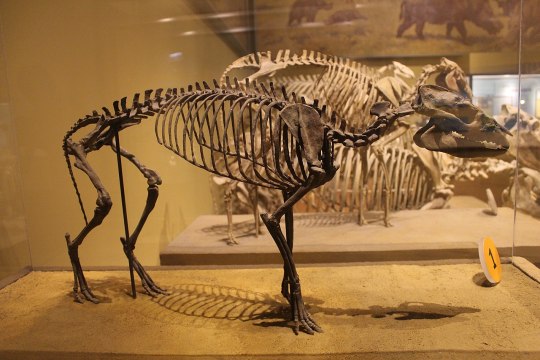
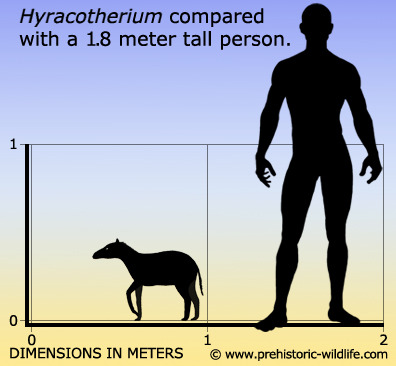
Hyracotherium leporinum
(temporal range: 55-45 mio. years ago)
[text from the Wikipedia article, see also link above]
Hyracotherium (/ˌhaɪrəkoʊˈθɪəriəm, -kə-/ HY-rək-o-THEER-ee-əm; "hyrax-like beast") is an extinct genus of very small (about 60 cm in length) perissodactyl ungulates that was found in the London Clay formation. This small, fox-sized animal is (for some scientists) considered to be the earliest known member of Equidae before the type species, H. leporinum, was reclassified as a palaeothere, a perissodactyl family basal to both horses and brontotheres. The remaining species are now thought to belong to different genera, such as Eohippus, which had previously been synonymised with Hyracotherium.
5 notes
·
View notes
Text
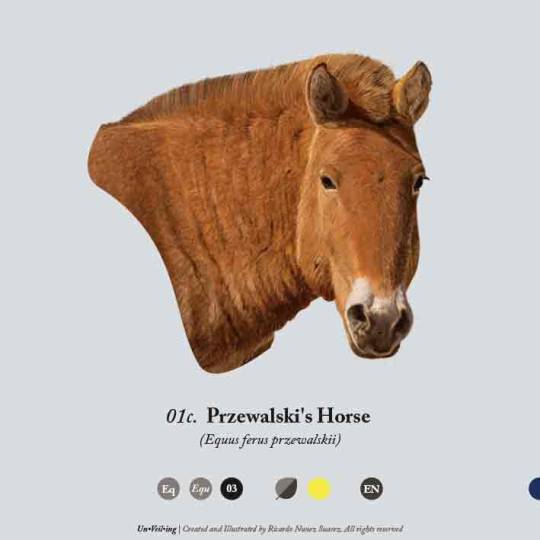
Przewalski's Horse
Equus ferus przewalskii
Family: Equidae
Genus: Equus
Subspecies: 03
Feed: Herbivorous
Habitat: Temperate Steppe
Status and Conservation: Critically Endangered
This is the only remaining species of wild horse. The other two wild horse species have already become extinct. One of them is the Tarpan (which was mentioned in a previous post), and the other is the European Wild Horse, which went extinct during the Pleistocene era. The other horses that roam in the wild are considered feral, which means they were once domesticated horses that have reverted to a wild state.
The Przewalski Horse was also extinct in the wild at one point. However, thanks to various breeding programs and the efforts of different zoos, it has been successfully reintroduced to its natural habitat in Mongolia and China. It is still classified as Critically Endangered."
________________________________
Credits:
Handbook of The Mammals of the World. Hoofed Animals.
________________________________
Thank you for being here. Likes, reblogs, and follows are very much appreciated. See you next week with more mammals. A new family to show! Huuuuuuuuu
#przewalski's horse#horse#caballo#love horses#horse lover#wild horse#feral horse#illustration#drawing#scientific illustration#illo#wild animals#wildlife#animals#artist on tumblr#mammals#animal#critically endangered#inforgraphics
75 notes
·
View notes
Text
gf showed me a video of a zebra eating snacks with its little tongue shaped like a ladle and she said horses can’t eat like that and i said that’s just a horse that can do that and this followed
Is a zebra a horse?
Zebras are closely related to horses but they're not the same species. They're both in the Equidae family and they can even breed with each other.
The offspring (zebroids) have different names dependent on the parents. A male zebra and female horse produces a zorse, and a female zebra and male horse produces hebra. Zebras can also breed with donkeys, to produce a zedonk.
Offspring of all crossovers are sterile, as zebras, horses and donkeys have different numbers of chromosomes.
this is what it looks like



I WANT A LITTLE ZEDONK PLEASE LOOK AT ITS STRIPEY LEGS ARE YOU KIDDING ME 😭
14 notes
·
View notes
Text

Another sign of poorly written romance: making up shit about some lore in the fandom to make it seem that their pairing makes sense even though there’s no proof that whatever “soul compatibility” is, exists.
If we’re being serious here, horses and deer are more different than similar. Yes, they are mammals, have four legs, and are ungulates (hoofed animals). However, deer (cervidae) and horses (equidae) do not live in the same family. Deer are ruminant, while horses aren’t. Horses have one stomach, while deer have a compartmented stomach. So in conclusion, if “soul compatibility” exists within a patronus have very poor “soul compatibility” if we are comparing the two animals.
Just found this online, and I just thought it was kind of funny because Harmony shippers bring up how Jack Russell terriers hunt otters (reference to Ron/Hermione’s patronuses, but here we have now a horse at least assisting hunting down a stag:

12 notes
·
View notes